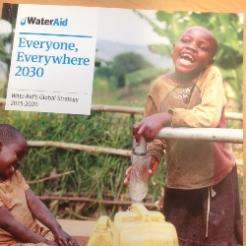WaterAid has launched a new five-year global strategy in line with the anticipated UN Sustainable Development Goal of eradicating extreme poverty worldwide by 2030.
The strategy reaffirms a commitment to political campaigning, but does not set a new income target, despite the charity having achieved an impressive 80 per cent growth in the last five years.
In September, the UN General Assembly will meet in New York to attempt to agree on 17 new Sustainable Development Goals (SDGs), the crux of which have been thrashed out by member nations over the last three years.
The overarching theme of the new SDGs is to eradicate extreme poverty by 2030. WaterAid’s chief executive Barbara Frost described this objective as “a wonderfully inspirational and aspirational vision” but added that “you can’t eradicate extreme poverty unless you have water and sanitation for all”.
In line with this, the international development charity has devised a new five-year strategy that focuses its efforts and resources on helping to make this goal a reality. The name of the strategy is: ‘Everyone, Everywhere 2030’.
The strategy document points out that 500,000 children die around the world each year from diseases caused by lack of access to safe water, sanitation and hygiene; and that 10 per cent of the world’s population lives without safe water to drink. One in three people have no decent toilet.
The strategy outlines WaterAid's four key aims – equality of access to safe water, sanitation and hygiene; supporting service providers to strengthen these services; integrating water, sanitation and hygiene into sustainable development, and influencing the behaviour of people around hygiene. These are based on the charity’s assessment of how it can best influence change. The strategy also links the work of all WaterAid members – the UK, US, Australia, Japan, Canada and Sweden.
“This year is incredibly important for WaterAid,” said Frost. “The prospect of getting water and sanitation firmly on the international agenda is starting to become very real. We’ve been looking at what can we do as an NGO, among very many huge players, governments and everyone else, to make change happen.
“What’s exciting about these new goals is that the Millennium Development Goals were just about poverty, but the SDGs are about poverty and sustainability, people and planet, and bringing that all together.
“The climate change talks in December are also critically important and before that there’s a big Financing for Development conference in Addis Ababa in July.” And at the end of last month, WaterAid representatives attended AfricaSan, a big sanitation conference in Senegal, where all the African governments came together to talk about their expectations for the future, under the strapline ‘Making sanitation for all a reality in Africa’.
"So it’s a very exciting time for us," said Frost.
She said WaterAid’s intention is to influence the UN decision-makers to ensure that there is a goal on water and sanitation among the SDGs. “Otherwise it is women and girls that will suffer, and development won’t take off. Sustainable development won’t happen.”
But she insists that eradicating extreme poverty within the timescale outlined by the UN is a realisable objective, citing women’s suffrage and the eradication of polio as historical events that seemed unachievable at the time. “It’s achievable if governments make the commitment,” she said. “It needs absolutely strong and committed political will and resourcing and determination. But it definitely is achievable and that’s what we are pushing for.
“Whatever WaterAid can do can only be a proverbial drop in the ocean, so we’re trying to influence the big players, the global decision-makers, because huge amounts of money needs to go into water and sanitation but it needs to get to the poor as well as the rich.”
The new five-year strategy doesn’t specify an income target for the organisation, as WaterAid’s last six-year strategy did. “Our last global strategy included a highly ambitious target to increase our income enormously to £100m,” Frost said. “We didn’t quite get there – last year our income was £83m – but we launched it in 2008 just as the economic crash happened, and suddenly the pound was buying us a lot less rupees and other currencies.
“But fortunately we had good reserves and we went out with the message that we know the British people are incredibly generous, and all those people who are without water and sanitation are still without it after the crash, so we are not going to cut back on our fundraising and other activities. We agreed to use our reserves to underwrite all our commitments. And we came through the financial crisis with slower growth than we’d hoped, but we still grew.”
WaterAid currently works in 37 countries around the world; by 2020 it anticipates this will rise to 40 countries.









